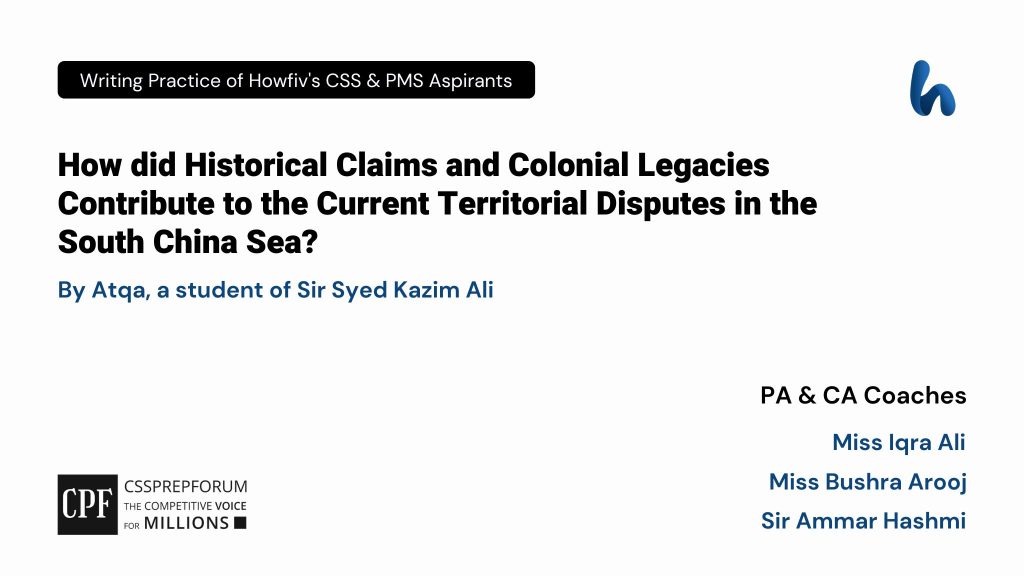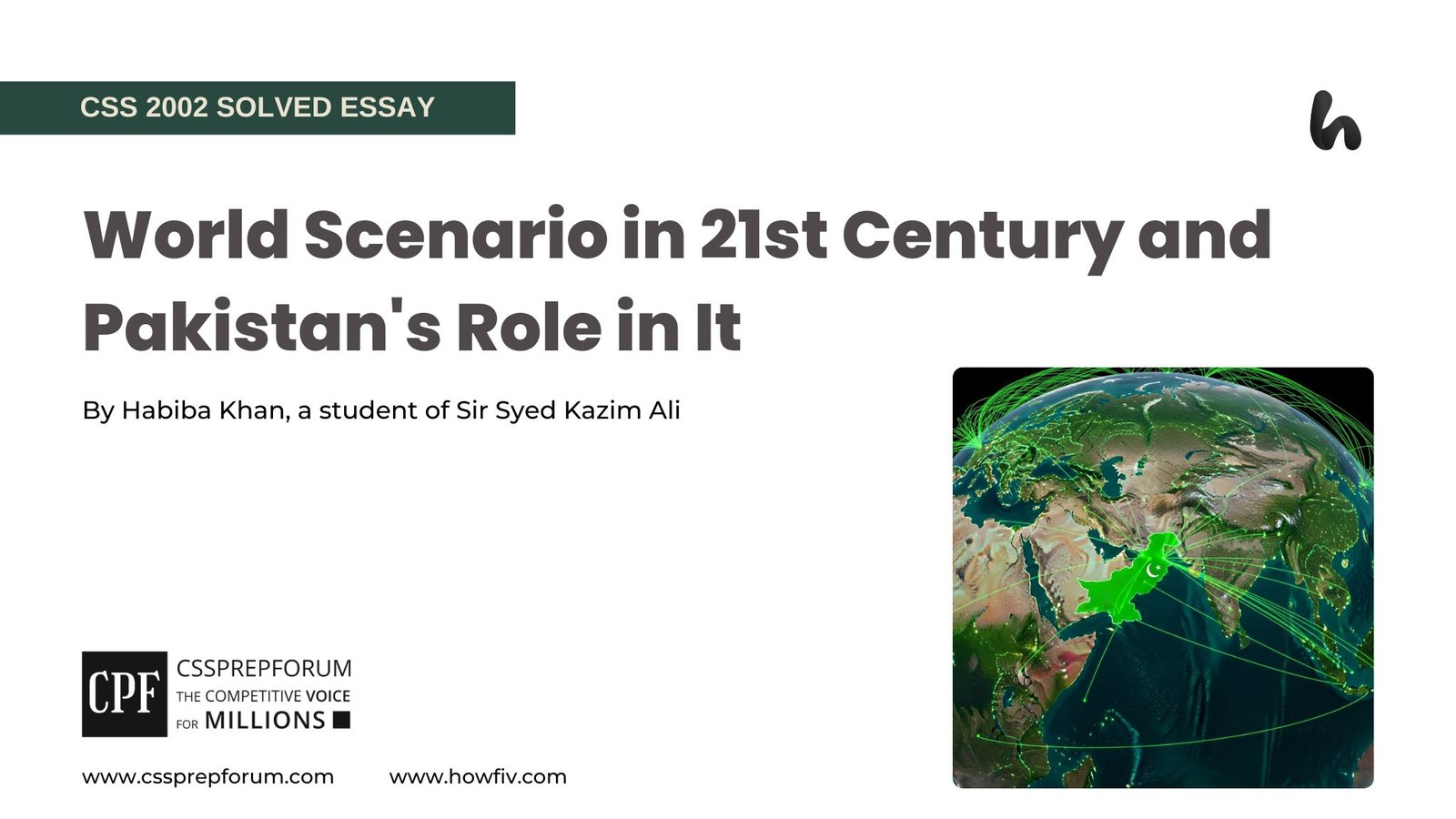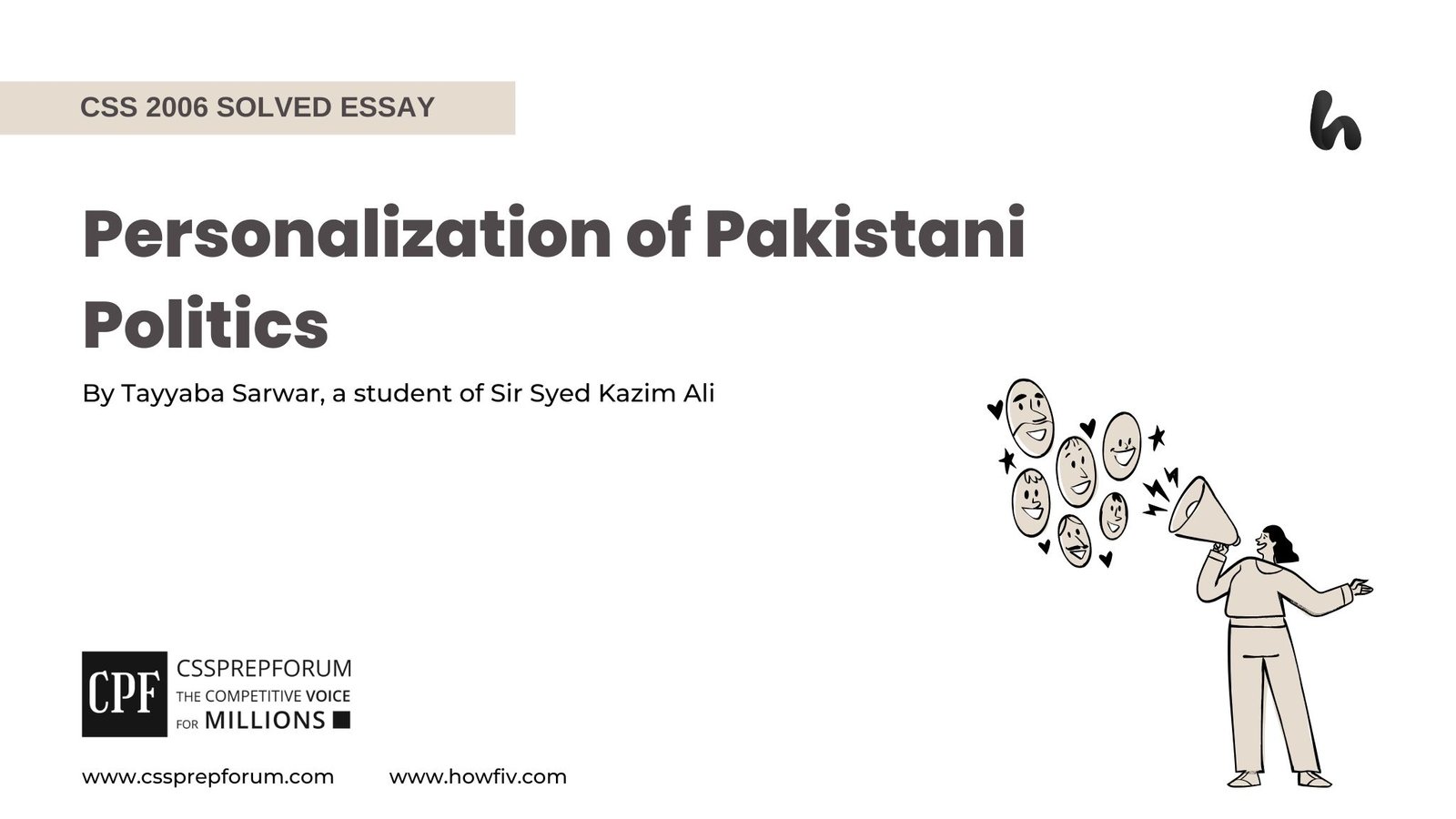CSS Current Affairs | History of the Territorial Disputes in the South China Sea
The following question of CSS Current Affairs is solved by Atqa under the supervision of Howfiv’s Pakistan Affairs and Current Affairs Coaches. She learnt how to attempt 20 marks question and essay writing from Sir Syed Kazim Ali, Pakistan’s best CSS and PMS English essay and precis teacher with the highest success rate of his students. This solved past paper question is attempted on the pattern taught by Sir to his students, scoring the highest marks in compulsory and optional subjects for years, and uploaded to help aspirants understand how to crack a topic or question, how to write relevantly, what coherence is, and how to include and connect ideas, opinions, and suggestions to score the maximum.

Outline
1- Introduction
2- The importance of the South China Sea in the 21st century
3- Cursory glance at the dispute of the South China Sea
4- How historical claims contribute to the current territorial disputes in the South China Sea
- ✓China’s claim regarding the South China Sea
- Case in point: Maritime Trade Map of Ming dynasty (1430s) and historical record of Qing dynasty (1892-1945)
- ✓Vietnam’s claim about the South China Sea
- Case in point: historical record of the era of Nguyen’s dynasty
- ✓Other Southeast Asian countries claim
- Case in point: historical records of Spanish colonialism in the Philippines and historical records of British colonialism in Malaysia and Brunei
5- How did colonial legacies contribute to the current territorial dispute in the South China Sea
- ✓Historical records left by colonial power
- Case in point: Nine dash-line claims of China
- ✓Cessions of territories by colonial power
- Case in point: Spain granted Spratly Island from China to the Philippines and then to the United States in 1889 through the Treaty of Paris
- ✓Legacy of troop presence in the region
- Case in point: French military presence in Vietnam, British military presence in Malaysia, and Japan’s military presence in the Spratly Islands during World War II
6- Critical analysis
7- Conclusion

Answer to the Question
Introduction
The South China Sea is an Asia-Pacific region with economic, strategic, and political importance. Also, it is a hub of disputes between China and other smaller countries in the region, such as Vietnam, Malaysia, and the Philippines. All these depute roots can be traced back to the colonial era and unclear boundaries set in the era of different dynasties. For instance, China claims based on the Maritime trade map and the Qing dynasty, Vietnam claims based on the Nguyen dynasty, and the Philippines claims based on historical records in the era of Spanish colonialism. Similarly, the colonial legacy of the cession of territories and the presence of troops in the region all combined shape the current complex geopolitical landscape. Hence, it is crucial to understand the historical claims and colonial legacies contributing to the current territorial dispute to resolve the ongoing conflict peacefully, prioritize the local population instead of colonial power legacies, and maintain and promote peace.

Importance of the South China Sea in the 21st century
In the 21st century, importance has been given to maritime resources, ocean, and sea level in global politics instead of physical boundaries, which has changed the traditional concept of hegemony. China and the USA compete extensively in international and regional politics, especially in the South China Sea (SCS). Moreover, there are also historical claims about SCS by littoral states, including China, Vietnam, Brunei, Malaysia, and the Philippines. Claims on the sea are because of numerous resources, such as oil, gas, and sea-based minerals. Additionally, it is one of the world’s largest seas, which consists of an area of 3500,000 sq km and has more than 250 small islands. Also, the sea carries ⅓ of the world’s ships; annually, $3.7 trillion in trade passes through this sea. Furthermore, it is also one of the most critical energy trade routes; annually, 1/3 of world crude oil and ½ of LNG pass through this route. Additionally, SCS has critical checkpoints, such as the Straits of Taiwan and Malacca. Thus, SCS has become necessary in the 21st century for the following reasons.
A cursory glance at the dispute of the South China Sea
The South China Sea (SCS) has become a source of tension among the following countries: China, the Philippines, Vietnam, Malaysia, and Brunei. The tension is escalating with time, especially between China and the Philippines. China is increasing its influence in the region through military means. In response, the USA also interfered in conflict to support its aligned countries and increased its military presence. Besides this, economic activities were also affected due to the dispute because, through this lane, 1/3 of the world’s shipping passes.
How historical claims contribute to the current territorial disputes in the South China Sea
- China’s claim regarding the South China Sea
First and foremost, China’s claim is based on the historical map in which it is shown that the South China Sea belong to China, and its current claims are firmly based on past evidence, which is the main reason for the current territorial dispute in the region. For instance, the Maritime Trade Map of the Ming Dynasty (1430s) and the historical record of the Qing Dynasty (1892-1945). The map of the Ming dynasty, known as the “Mao Kun map”, illustrates that China had control over SCS and the Spratly Islands were also in control of China. Likewise, during the Qing dynasty, China controlled SCS, including the Paracel Islands. According to the Chinese, these two are the main events that highlight Chinese sovereignty in the sea. Thus, these claims of Beijing are the primary source of tension.
- Vietnam’s claim about the South China Sea
Second, Vietnam’s claims of Spratley and Paracel Islands are deeply rooted in history, another cause of territorial dispute in the region. Vietnam specifically supports their claims with the historical records of the Nguyen dynasty era. As per them, the Nguyen dynasty has been practising its administration over the islands since the 17th century. The Nguyen dynasty emperor issued a map showing the Spratley and Paracel Islands as Vietnam territory. Moreover, its historical records and documents, such as “Dai Nam Thuc Luc, ” provide evidence of Vietnam’s sovereignty over the Spratley and Paracel Islands. In this way, its historical claims contribute to the ongoing territorial dispute.
- Other Southeast Asian countries claim
Other Southeast Asian countries claim, including claims the Philippines, Malaysia, and Brunei. These countries’ claims are also based on the following historical records: historical records of Spanish colonialism in the Philippines and British colonialism in Malaysia and Brunei. When the Philippines was under the control of a Spanish colony, Spain gave them some islands of the South China Sea through a treaty, so the Philippines backed their stance with that historical record. Moreover, Malaysia and Brunei were part of British colonialism, so Malaysia claimed they had sovereignty over those islands which were part of a British colony before independence; now, after independence, these islands automatically belonged to them. Furthermore, Brunei was also a protectorate of the British during the British colonialism treaty signed between Britain and Brunei, in which it was declared the sovereignty of Brunei on the SCS and Spratly Islands. Thus. These countries’ claims also fuel the current territorial dispute; however, Brunei’s claim is relatively modest and wants to resolve the current dispute peacefully.
How did colonial legacies contribute to the current territorial dispute in the South China Sea?
- Historical records left by colonial power
First, colonial legacies set ambiguous and unclear boundaries that led to overlapping claims on the South China Sea (SCS), due to which China used a nine-dash line to justify their expensive claim of SCS. However, other countries rejected China’s claim and gave their historical records and international law regarding the dispute. Thus, this legacy act contributes to the current territorial dispute and power imbalance between China and neighbouring countries and complicates a peaceful resolution.
- Cessions of territories by colonial power
Furthermore, treaties and agreements during the colonial era are another cause of the current territorial dispute on the South China Sea (SCS). One of the glaring examples is when Spain granted Spratly Island from China to the Philippines and then to the United States in 1889 through the Treaty of Paris. The Philippines argues that the will of the Philippian people did not sign this treaty. Due to these agreements and treaties of the colonial era, many conflicting claims about sovereignty over the Spratly Islands fuel the current territorial dispute in the SCS.
- legacy of troop presence in the region
Last but not least, another major cause of territorial dispute in the South China Sea (SCS) is the presence of military troops in the region, establishing rivals of the military and further exacerbating tension in the area. For instance, the French military presence in Vietnam, the British military in Malaysia, and the Japanese military in the Spratly Islands during World War II. Installation of the foreign military in the region during the colonial era created a sense of troop presence in the SCS among China; therefore, due to China’s military presence, other smaller neighbouring countries felt a threat to their sovereignty, further exaggerating the ongoing dispute.
Critical analysis
A robust analysis highlights how historical claims and colonial legacies contribute to the current territorial dispute in the South China Sea (SCS). Therefore, the claims of China are based on a historical map, the claims of Vietnam, which is based on the Nguyen dynasty, and the claims of other Southeast Asian countries are based on the historical record of the colonial era. In addition to this, colonial legacies further exacerbate the situation, such as historical records of that time, cession of territories, and troop presence. However, it is essential to recognize that dispute only prioritizes colonial power over the local population, so to resolve the issue peacefully, it is crucial to manage colonialism’s ongoing impact and hear the local population’s voice.
Conclusion
On the final count, the current dispute between China and other littoral states is shaped by historical claims and colonial legacies. Historical claims reflect the claim of China, which is based on documents and maps of the Ming Dynasty and Qing Dynasty. Vietnam’s claim is based on the Nguyen dynasty, the Philippines’ claim is based on the historical record of the Spanish colonialism era, and Malaysia’s claim is based on the historical record of British colonialism. Colonial power legacies included handing over sovereignty of the island, reefs, and water to other colonial powers or countries and a legacy of military presence. So, there is always a light at the end of the tunnel; countries can overcome current disputes by addressing the historical impact of colonialism and its effects on the geopolitical landscape. After analyzing the situation, China and other smaller neighbouring countries should negotiate and build mutual understanding to resolve the issue.

CSS Solved Past Papers’ Essays
Looking for the last ten years of CSS and PMS Solved Essays and want to know how Sir Kazim’s students write and score the highest marks in the essays’ papers? Then, click on the CSS Solved Essays to start reading them.
CSS Solved Essays
CSS Solved General Science & Ability Past Papers
Want to read the last ten years’ General Science & Ability Solved Past Papers to learn how to attempt them and to score high? Let’s click on the link below to read them all freely. All past papers have been solved by Pakistan’s top CSS GSA coach having the highest score of their students.
General Science & Ability Solved Past Papers












